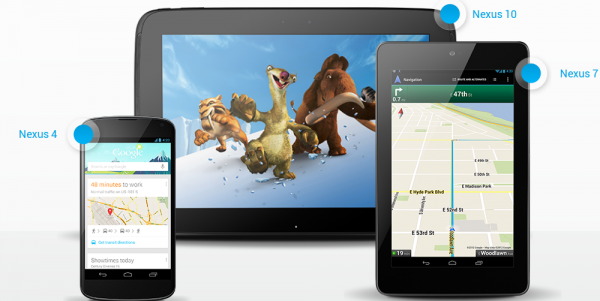Google Play starts selling new Nexus 4, 7 and 10 devices

Today Google released Android 4.2 and new devices -- Nexus 4 and Nexus 10 -- running the software. The Nexuses (Should I say Nexi?) are available in Australia, Canada, France, Germany, Italy, Spain, United Kingdom and United States. Unconfirmed user reports on blogs and social networks claim sell-outs in Asia-Pacific and Europe. Sales in North America commence at 9 am PT, from Google Play, representatives confirm.
LG makes the 4.7-inch smartphone and Samsung the 10.1-inch tablet, which join the ASUS-manufactured Nexus 7. The cloud services company announced the new products on October 29.
The new smartphone replaces flagship Galaxy Nexus, which Google and Samsung unveiled about a year ago. Nexus 7 is a four-month old product that today gets larger storage capacities for same pricing and addition of a new 3G cellular HSPA+ model. Nexus 10 is a new product category for Google -- 10.1-inch tablet.
If BetaNews polls are any indication, there is great interest in the new smartphone and larger tablet. Fifty-four percent of respondents say they will buy Nexus 4 "as soon as available", which is today, and 14.83 percent within 3 months. As for the Nexus 10, 44.44 percent of respondents plan to buy "as soon as available" and another 18.45 percent within 3 months.
Google's nomenclature is a bit odd. The numerals for the two tablets, refer to screen size, while Nexus 4 refers to fourth-generation smartphone.
Nexus 4 specs: 4.7-inch IPS display, 1280 x 768 pixel resolution, 320 pixels per inch; Qualcomm Snapdragon S4 Pro processor; 2GB RAM; 8GB or 16GB storage (depending on model); 8-megapixel rear-facing and 1.3MP front-facing cameras; GSM/EDGE/GPRS (850, 900, 1800, 1900 MHz), 3G (850, 900, 1700, 1900, 2100 MHz), HSPA+ 21; WiFi N; wireless charging; Bluetooth; NFC; SlimPort HDMI; accelerometer; ambient-light sensor; barometer; compass; GPS; Gyroscope; microphone; 2,100 mAh battery; unlocked; Android 4.2. Measures 133.9 x 68.7 x 9.1 mm and weighs 139 grams.
The 8GB model sells for $299 and the larger-capacity one for $349. Starting November 14, T-Mobile will offer a Nexus 4 model for $199.
Nexus 7 specs: 7-inch back-lit IPS display, 1280 x 800 resolution, 216 ppi; 1.3GHz Nvidia Tegra 3 quad-core processor; 1GB RAM; 16GB or 32GB storage (depending on model); 1.2-megapixel front-facing camera; GSM/EDGE/GPRS (850, 900, 1800, 1900 MHz), 3G (850, 900, 1700, 1900, 2100 MHz), HSPA+ 21 (one model); WiFi N; Bluetooth; accelerometer; GPS; gyroscope; magnetometer; microphone; NFC; 4325 mAh battery; unlocked; Android 4.2. Measures 198.5 x 120 x 10.45mm and weighs 340 grams.
Three models are available: 16GB ($199); 32GB ($249); 32GB with 3G ($299).
Nexus 10 specs: 10.055-inch display, 2560 x 1600 resolution, 300 ppi; 1.7GHz Exynos 5 (Cortex A-15) dual-core processor; Mali T604 graphics chip; 2GB of RAM; 16GB or 32GB storage (depending on model); 5MP back- and 1.9MP front-facing cameras; WiFi N; micro HDMI; Bluetooth; accelerometer; ambient-light sensor; barometer; compass; GPS; gyroscope; microphone; NFC; 9000 mAH battery; Android 4.2. Measures 263.9 x 177.6 x 8.9 mm and weighs 630 grams.
Google sells the 16GB Nexus 10 for $399 and the 32GB one for $499.
By working with existing Android manufacturers, Google works to end ecosystem-wide fragmentation. For example, LG and Samsung typically are slow to update their Androids to the newest version of the operating system. Consider Samsung: Based on price and features alone, Google gives potential tablet buyers good reasons to make Nexus 10 the Samsung they buy. The pure Android model makes Galaxy Tab 10.1 obsolete and leaves the stylus Galaxy Note 2's only compelling feature. Samsung is an Android fragmenter, too, because of TouchWiz and slow OS updates. Nexus 10 solves that problem, or so I predict.
Google could have Nexus devices via its Motorola subsidiary. Working with partners that otherwise contribute to fragmentation is smart.
